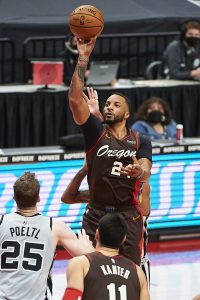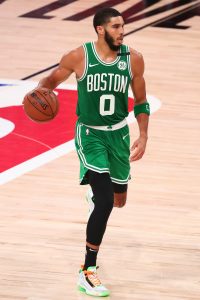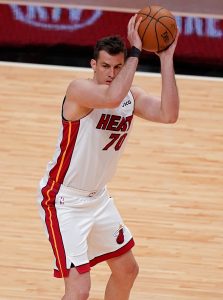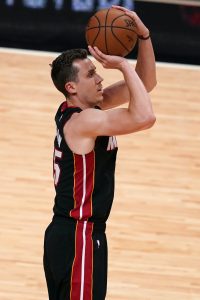Although the races for the final playoff positions in the Eastern and Western Conference will generate more excitement during the last week of the NBA’s 2020/21 season, the jockeying for lottery positioning near the bottom of the league’s standings may ultimately be more meaningful in the long run. The seventh and eighth seeds rarely win a playoff series, but at least one or two teams generally land franchise-changing players in the draft lottery every year.
The lottery odds have been flattened and the format has been tweaked enough in recent years that finishing at or near the bottom of the NBA standings doesn’t necessarily guarantee a top spot in the draft. But teams can still improve their odds of landing a top pick based on where they finish in the standings.
With the help of our reverse standings tool, here are a few lottery situations and races to watch down the stretch:
The Rockets will clinch the lottery’s top spot
It’s not official yet, but the Rockets (16-52) will finish the season with the NBA’s worst record and the No. 1 spot in the lottery standings. They could formally secure that spot with a loss on Monday night in Portland.
Because the top three teams in the lottery standings will each have identical odds at the No. 1 pick (14.0%) and at a top-four pick (52.1%), it’s not necessarily a huge advantage to finish with the NBA’s worst record instead of the third-worst record. However, the Thunder will certainly appreciate the Rockets finishing dead last instead of third-last.
The Rockets will be forced to sent their pick to Oklahoma City in exchange for Miami’s first-rounder, but only if it falls outside of the top four. That means Houston will have a 52.1% chance to hang onto its pick and a 47.9% chance of sending it to the Thunder.
If the Rockets had finished third in the lottery standings, those odds wouldn’t change, but the pick could slip as far as sixth or seventh if multiple teams leapfrog Houston in the lottery. Because the Rockets will be No. 1 in the lottery standings, that pick can’t fall further than fifth overall — that would be the ideal outcome for Oklahoma City and there’s a 47.9% chance it will happen.
The Nos. 2 through 6 spots are up for grabs
The Pistons (20-49) currently rank second in the lottery standings, followed by the Thunder (21-48), then the Magic, Timberwolves, and Cavaliers (all 21-47).
The win column is the key number to watch here, since some of these clubs may not win another game during the season’s final week. So Detroit has a slight leg up on the second spot, but a single Pistons win could really create some chaos.
While all of these teams have fairly challenging remaining schedules, Detroit and Minnesota are the ones to watch. Their schedules are the easiest of the five, per Tankathon, largely because they’ll face one another in Detroit on Tuesday.
The Timberwolves, of course, are the one team in this group not particularly motivated to tank, since their pick will be sent to the Warriors if it’s not in the top three.
Here are the lottery odds these five teams will be looking at, based on their finishes:
| # |
1 |
2 |
3 |
4 |
5 |
6 |
7 |
8 |
9 |
10 |
| 2 |
14 |
13.4 |
12.7 |
12 |
27.8 |
20 |
– |
– |
– |
– |
| 3 |
14 |
13.4 |
12.7 |
12 |
14.8 |
26 |
7 |
– |
– |
– |
| 4 |
12.5 |
12.2 |
11.9 |
11.5 |
7.2 |
25.7 |
16.7 |
2.2 |
– |
– |
| 5 |
10.5 |
10.5 |
10.6 |
10.5 |
2.2 |
19.6 |
26.7 |
8.7 |
0.6 |
– |
| 6 |
9 |
9.2 |
9.4 |
9.6 |
– |
8.6 |
29.8 |
20.6 |
3.7 |
0.1 |
When two teams finished with identical records, their lottery odds also become identical (or as close to it as possible). For instance, if two teams tie for No. 4 in the lottery standings, they’d both have an 11.5% chance at the No. 1 pick — the middle ground between 12.5% and 10.5%. The same rules apply in the event of a three-team tie.
In each of those instances, a random tiebreaker determines which team technically places higher in the lottery standings. That tiebreaker determines how far a team can fall in the draft order and sometimes gives a team an extra “ping-pong ball.”
For instance, if three teams finish tied for the No. 4 spot in the lottery standings, the team that wins the tiebreaker would have a 10.7% chance at the top pick and couldn’t fall further than No. 8. The club that loses the three-team tiebreaker would have a 10.6% chance at the No. 1 pick and could fall as far as No. 10.
Given how close this section of the lottery race is, it’s safe to assume we’ll see at least one tie in the end-of-season standings.
The Raptors are in the lead for the No. 7 spot
The Raptors (27-41) can’t move up higher than No. 7 in the lottery standings, but they’re in a good position to secure that spot, with a multi-game cushion on the Bulls (29-30), Kings (30-38), and Pelicans (31-37). Those three clubs have pushed harder for a spot in the play-in tournament than Toronto has.
Assuming the Raptors finish with the seventh-best odds, they’ll have a 7.5% chance at the No. 1 pick and a 31.9% chance to move into the top four. As for the Bulls, if they remain at No. 8, they’ll have a 6.0% chance at No. 1 and a 26.2% shot a top-four pick — those odds are especially important, since Chicago will send its pick to Orlando if it falls outside the top four.
Meanwhile, the 10 teams that miss out on play-in spots will be joined in the lottery by the four teams eliminated in the play-in games — even if one or more of those teams finished the regular season ranked seventh or eighth in the conference.
For instance, let’s say the season ended today, making the 38-30 Lakers the No. 7 seed in the West. In the unlikely event that they lost two consecutive play-in games, they’d move into the lottery standings at No. 14, whereas if they were to secure a postseason berth in the play-in tournament, their pick would land in the early 20s.
Los Angeles will keep its first-rounder if it falls in the 8-30 range, so if the Lakers end up in the play-in, New Orleans will be actively rooting against them — should the Lakers miss the playoffs, there’s a chance their pick could move into the top four via the lottery, in which case it’d be sent to the Pelicans.
 Norman Powell
Norman Powell June 22: NBA draft lottery (8:30pm ET)
June 22: NBA draft lottery (8:30pm ET) Fox probably has no chance at making an All-NBA team, given the competition at guard and the Kings’ spot in the standings. The other three players here have better cases, but Adebayo is likely a long shot, making Mitchell and Tatum the most realistic candidates. They’d only need to sneak onto the Third Team to increase the projected value of their new five-year deals by more than $32MM.
Fox probably has no chance at making an All-NBA team, given the competition at guard and the Kings’ spot in the standings. The other three players here have better cases, but Adebayo is likely a long shot, making Mitchell and Tatum the most realistic candidates. They’d only need to sneak onto the Third Team to increase the projected value of their new five-year deals by more than $32MM. Embiid is still under contract for two more years beyond 2020/21, which is why he’d only be able to tack on four new years to his current deal instead of five. Jokic is in a similar spot, but because he’ll only have six years of NBA service at the end of this season, he’d have to wait until 2022 to officially sign an extension, at which point he’d be eligible for five new years instead of just four.
Embiid is still under contract for two more years beyond 2020/21, which is why he’d only be able to tack on four new years to his current deal instead of five. Jokic is in a similar spot, but because he’ll only have six years of NBA service at the end of this season, he’d have to wait until 2022 to officially sign an extension, at which point he’d be eligible for five new years instead of just four. Nemanja Bjelica
Nemanja Bjelica With all that in mind, let’s check in on how this year’s RFAs-to-be will be impacted by the starter criteria. Listed below are the former top-14 picks on track for restricted free agency who have not met the starter criteria. These players will be eligible for qualifying offers worth $7,031,451.
With all that in mind, let’s check in on how this year’s RFAs-to-be will be impacted by the starter criteria. Listed below are the former top-14 picks on track for restricted free agency who have not met the starter criteria. These players will be eligible for qualifying offers worth $7,031,451. The players listed below signed as second-round picks or undrafted free agents, but have met the starter criteria and are now eligible for a qualifying offer worth $4,736,102.
The players listed below signed as second-round picks or undrafted free agents, but have met the starter criteria and are now eligible for a qualifying offer worth $4,736,102.